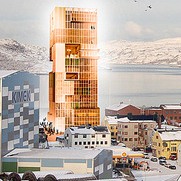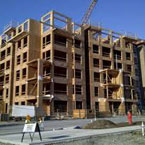 A Canadian proposal to increase the maximum height of wood buildings from four to six stories has ignited a debate between the Canadian Wood Council and the Cement Association of Canada over the “health, safety, accessibility, fire and structural protection” of these buildings.
A Canadian proposal to increase the maximum height of wood buildings from four to six stories has ignited a debate between the Canadian Wood Council and the Cement Association of Canada over the “health, safety, accessibility, fire and structural protection” of these buildings.
 Wood structures have grown in popularity recently as architects, engineers and designers look to reduce the carbon footprint of buildings. In addition to the Barents 16-story wood building currently underway in Norway, making news this year alone is the proposed construction of a 34-story wooden high-rise building in Stockholm and in North America, the Timber Tower 42-story wood tower, designed by architects Skidmore Owings & Merrill.
Wood structures have grown in popularity recently as architects, engineers and designers look to reduce the carbon footprint of buildings. In addition to the Barents 16-story wood building currently underway in Norway, making news this year alone is the proposed construction of a 34-story wooden high-rise building in Stockholm and in North America, the Timber Tower 42-story wood tower, designed by architects Skidmore Owings & Merrill.
"The reality is that advances in wood science and building technology have resulted in stronger, safer, more sophisticated and robust products that are expanding the options for wood construction, and providing more choices for builders and architects. These changes are fully supported by science from renowned organizations such as FPInnovations and the National Research Council," Michael Giroux, president of the Canadian Wood Council, said recently in a statement.
Challenging that viewpoint is the Cement Association of Canada which last week announced a national campaign to fight the changes in Canada’s building code, saying the implications of the taller wood structures “have not yet been fully and completely analyzed.”
"Wood burns, concrete doesn't," said Michael McSweeney, president and CEO of the Cement Association of Canada. "Those who promote the interests of building with wood may not like that fact, but it's a fact. And that's why we - and firefighters like [Fire Fighters Association of Ontario past president] Carl Pearson, and many others - are stepping up to oppose the building code changes that would see mid-rise all-wood buildings permitted in Canada and demand the implementation of several provisions to mitigate the potential risks posed to vulnerable Canadians."
The association disputes the findings of the Canadian Commission on Building and Fire Codes joint task group which found that height and area limits for residential and commercial buildings constructed of combustible materials could safely be increased to six stories with the implementation of new and/or modifying protective measures. The task group considered: fire protection (building elements); emergency response (fire code requirements); building and plumbing services; and structural and earthquake design in making its determination.
Code users and stakeholders have until 4 p.m. EST Dec. 23 to submit their comments to the Canadian Commission on Building and Fire Codes. If approved, the changes will be published in the 2015 editions of Canada’s National Model Construction Codes.
"The campaign launched from cement has less to do with safety and more to do with maintaining the status quo in construction. This is really about market share and their fear of competing on the street." Giroux said.
This debate is the latest between the Canadian groups over wood as a construction material. Earlier this year, cement and steel producers voiced their displeasure over the government’s continued support of wood for high-rises over other building materials, especially as the economy continues to recover. The latest incident to draw their ire is the $25 million “support” given by the BC government for construction of one of the largest commercial buildings made of principally of wood, the Wood First program’s Wood Innovation and Design Centre.
These debates have an impact beyond Canadian shores, as the U.S. and other nations grapple with these same topics.Which leads to these questions:
1. Should a taxpayer-sponsored agency promote the interest of one group, perhaps at the expense of another?
2. Would you be comfortable living and/or working in a wood high rise? Why or why not?
Share your comments.



Have something to say? Share your thoughts with us in the comments below.